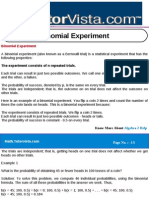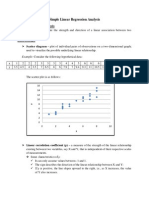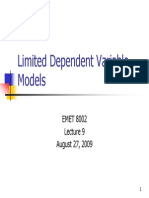Homework #3 - Answers Economics 113 Introduction To Econometrics Professor Spearot Due Wednesday, October 29th, 2008 - Beginning of Class
Uploaded by
Cheung TiffanyHomework #3 - Answers Economics 113 Introduction To Econometrics Professor Spearot Due Wednesday, October 29th, 2008 - Beginning of Class
Uploaded by
Cheung TiffanyHomework #3 Answers Economics 113 Introduction to Econometrics Professor Spearot Due Wednesday, October 29th, 2008 Beginning of class
ss 1. Please interpret the slope coefficient in each of the following four specifications: y = 0 + 1 x + y = 0 + 1 log( x) + log( y ) = 0 + 1 x + log( y ) = 0 + 1 log( x) + For the first specification:
y = 1 x
Thus, the slope coefficient equals the unit change in y after a unit change in x.
y = 1
x 1 x = *100 = 1 (percentage change in x ) x 100 x 100
Thus, the slope coefficient divided by 100 equals the unit change in y after a percentage change in x.
y = 1x y y * 100 = (1 * 100 )x y
Thus, the slope coefficient multiplied by 100 equals the percentage change in y resulting from a unit change in x.
y x = 1 y x y x * 100 = 1 *100 y x The slope coefficient gives the percentage change in y as a function of a percentage change in x.
2. For the following examples, discuss whether each satisfy the four assumptions we use for linear regression. If not, which assumptions are violated? a) To examine the link between attendance and grades, I construct an indicator variable, PickUp, which takes on the value of 1 if a student picked-up his or her exam on Friday, October 17th, and 0 otherwise. I then run the following regression using data for the entire class: ExamGrade = 0 + 1 PickUp + Here the problem is one of omitted variables. The indicator PickUp is likely correlated with a variable in the error term. For example, since studying probably improves your grade, and studying is likely correlated with your probability of attending class, there is bias in our estimates. In this case the assumption of zero conditional mean is violated.
b) To examine the link between studying and grades, I construct a new variable, Study, which is the self-reported hours-studied prior to the exam. The sampling was done on Friday, October 17th. Using this sample, I run the following regression: ExamGrade = 0 + 1 Study + You could make the same argument as in (a), instead using average attendance as the omitted variable. However, the bigger issue is that we are using a selected sample, so the random sampling assumption is violated. That is, we are only using the sample of those who attend class, which is likely not representative of the entire class. 3. Taken from Problem 3.7 in Wooldridge Which of the following can cause OLS estimators to be biased? (i) Heteroskedasticity (ii) Omitting an important variable (iii) A high correlation coefficient (say .95) between two random variables Only number two causes the estimators to be biased. Heteroskedasticity has to do with the estimates of error variance, which has nothing to do with the expected value of the parameter estimates. Further, high correlations only pose a problem for obtaining a precise estimate of variance.
You might also like
- Introduction To Statistical Learning: With Applications in RNo ratings yetIntroduction To Statistical Learning: With Applications in R13 pages
- Practice Exam 3 - Fall 2009 - With AnswersNo ratings yetPractice Exam 3 - Fall 2009 - With Answers6 pages
- 2015 Preparatory Notes: Australian Chemistry Olympiad (Acho)No ratings yet2015 Preparatory Notes: Australian Chemistry Olympiad (Acho)44 pages
- Econ 335 Wooldridge CH 8 HeteroskedasticityNo ratings yetEcon 335 Wooldridge CH 8 Heteroskedasticity23 pages
- Lecture3-Enriching the Linear Models Slides-AnnotatedNo ratings yetLecture3-Enriching the Linear Models Slides-Annotated42 pages
- Rss Grad Diploma Module4 Solutions Specimen B PDFNo ratings yetRss Grad Diploma Module4 Solutions Specimen B PDF16 pages
- Question 4 (A) What Are The Stochastic Assumption of The Ordinary Least Squares? Assumption 1No ratings yetQuestion 4 (A) What Are The Stochastic Assumption of The Ordinary Least Squares? Assumption 19 pages
- Handout 05 Regression and Correlation PDFNo ratings yetHandout 05 Regression and Correlation PDF17 pages
- Stochastic Simulation and Power Analysis: ©2006 Ben Bolker August 3, 2007No ratings yetStochastic Simulation and Power Analysis: ©2006 Ben Bolker August 3, 200725 pages
- Mathematica Laboratories For Mathematical StatisticsNo ratings yetMathematica Laboratories For Mathematical Statistics26 pages
- Linear Regression With One Variable - Coursera - Quiz-2No ratings yetLinear Regression With One Variable - Coursera - Quiz-24 pages
- Section 3: Logistic Regression: The Challenger DisasterNo ratings yetSection 3: Logistic Regression: The Challenger Disaster13 pages
- Chapter-9-Simple Linear Regression & CorrelationNo ratings yetChapter-9-Simple Linear Regression & Correlation11 pages
- Numerical Analysis I: California State University Northridge Lecture Notes For Math 481ANo ratings yetNumerical Analysis I: California State University Northridge Lecture Notes For Math 481A228 pages
- Econometrics and Softwar Applications (Econ 7031) AssignmentNo ratings yetEconometrics and Softwar Applications (Econ 7031) Assignment8 pages
- Lecture 3-1_Introduction to Multiple RegressionNo ratings yetLecture 3-1_Introduction to Multiple Regression48 pages
- Student's Solutions Manual and Supplementary Materials for Econometric Analysis of Cross Section and Panel Data, second editionFrom EverandStudent's Solutions Manual and Supplementary Materials for Econometric Analysis of Cross Section and Panel Data, second editionNo ratings yet
- Trimmed Sample Means For Uniform Mean Estimation and RegressionNo ratings yetTrimmed Sample Means For Uniform Mean Estimation and Regression36 pages
- Ebooks File Complete Probability & Statistics 2 For Cambridge International AS & A Level James Nicholson All Chapters100% (8)Ebooks File Complete Probability & Statistics 2 For Cambridge International AS & A Level James Nicholson All Chapters79 pages
- Full download Multilevel Modeling Using R (Second Edition) W. Holmes Finch pdf docx100% (1)Full download Multilevel Modeling Using R (Second Edition) W. Holmes Finch pdf docx65 pages
- Week 7: Estimation and Parameters: Objectives: at The End of The WeekNo ratings yetWeek 7: Estimation and Parameters: Objectives: at The End of The Week4 pages
- Convex Relaxations For Pose Graph Optimization With OutliersNo ratings yetConvex Relaxations For Pose Graph Optimization With Outliers10 pages
- Strengths and Limitations of Taguchi's Contributions To Quality, Manufacturing, and Process EngineeringNo ratings yetStrengths and Limitations of Taguchi's Contributions To Quality, Manufacturing, and Process Engineering54 pages
- Package Bootstrap': R Topics DocumentedNo ratings yetPackage Bootstrap': R Topics Documented28 pages
- Mca/1 Sem/ Mcap 1103/2016 Mca/1 Sem/ Mcap 1103/2016: ST STNo ratings yetMca/1 Sem/ Mcap 1103/2016 Mca/1 Sem/ Mcap 1103/2016: ST ST2 pages
























































































